 |
| The pillow-like puffs of white clouds against the bright blue sky and a few elephants create a heavenly scene in Kruger. |
“Sighting of the Day in the Bush”
 |
| This cute little bird landed in our bird feeder. According to our helpful friend Lynne, this is a juvenile male red-headed weaver. Thanks, Lynne! |
Not a day passes that we don’t hear from some of our readers contemplating changing their lives to travel the world. They often have many questions we’re always more than willing to answer based on our personal experiences over this past almost six years.
 |
| It’s always thrilling to see elephants along the road. |
We’ve had little to offer in a few cases when the inquirer is planning to backpack, stay in hostels, or use an RV, camper, or caravan. But, the majority of inquiries revolve around places we’d suggest, holiday/vacation home rental sites we prefer, health insurance and medical care, refilling prescriptions, car rentals, credit cards to use, visas, and the most cost-effective means of converting money.
 |
| Elephants crossing the road is extra special. |
We are always happy to oblige and most often respond within 24 hours. The irony of it all is that everyone travels differently. No single person or couple seems to do it precisely as we do.
 |
| And most exciting when large numbers of elephants cross the road. |
That’s the beauty of the vast numbers of primarily retirees/baby boomers who are making the drastic decision to change their lives. The single most significant difference in the way we travel and how others travel or desiring to travel may include some of these:
- We have no home, apartment, condo, or bedroom in the homes of family or friends where we go for downtime or regrouping.
- We have no storage anywhere. We unloaded everything we owned in our old lives.
- We own no rental property, often the traveler(s) former residence they keep in case “they change their minds” or tire of traveling. This may be a significant source of worry and stress; maintenance, management, rental issues, wear and tear, and market conditions. We each had owned homes for over four decades.
 |
| On our way to the Mug & Bean restaurant on Lower Sabie, we noticed it was raining at a distance. We certainly need rain here but most likely won’t encounter much for several months. |
- Typically we stay in vacation/holiday homes for one to three months. (Although this year in Africa is a rare exception, as mentioned in yesterday’s post, where we’re recovering from the big expense of the Antarctica cruise).
- Often, for short stays, we negotiate special pricing for hotels while we await the next venue.
- We use cruising as much as possible as a means of transportation while providing living arrangements during the sailing period. We don’t think of cruising as a holiday or vacation.
We have minimal luggage. If we purchase something to add to our bags, we must dispose of something else. Maximum kilogram per bag: 23 (50 pounds)
 |
| A waterbuck is looking across the river for possible predators. |
- We do not stay in the homes of family and friends. We don’t want to burden anyone with our peculiarities, nor do we expect a free ride (except for son Richard in Henderson, Nevada, where we’ll stay for a few weeks every two to three years. Thanks, Ricky!)
- We don’t have a “bucket list.” If we discover something along the way we’d like to do, we research, analyze the costs, and make a decision to include it in our itinerary.
- We often book some events two years in advance to continue shaping our itinerary. We thoroughly enjoy the planning process, with each of us playing a very active role.
- Every day, 365 days a year, we spend half of each day documenting our daily lives with photos. Doing so is not a chore for us. It’s a pure pleasure! We can write about the second part of each day we spend experiencing aspects of our lives the following day.
- Our overall goal: stress-free living.
 |
| There’s never a shortage of moms and babies. From this site: “Elephants have the longest gestation period of all mammals. These gentle giants’ pregnancies last for more than a year and a half. The average gestation period for an elephant is about 640 to 660 days or roughly 95 weeks. By comparison, a human pregnancy lasts an average of 280 days or 40 weeks. Female elephants live for 60 to 70 years, but only have about four offspring throughout their lifetime.” |
None of the above is stated to imply that the way we’re doing it is ideal. However, over these years, we’ve fine-tuned our goals, objectives, and expectations and are content with how we’ve chosen this path in life.
 |
| From this site: “The South African giraffe (G. c. giraffa) is found in northern South Africa, southern Botswana, southern Zimbabwe, and south-western Mozambique. It has dark, somewhat rounded patches “with some fine projections” on a tawny background color. The spots extend down the legs and get smaller. The median lump of males is less developed. A maximum of 31,500 are estimated to remain in the wild, and around 45 are kept in zoos.” |
However, we always welcome inquiries regardless of the ways you may choose to travel. Please don’t hesitate to inquire at any time. Also, if you know of someone interested in long-term lifestyle travel, please forward our site to their email.
 |
| Two giraffes are crossing the road near a historical marker on the paved road. |
Tonight, we’re heading out to dinner with friends Sandra and Paul (both MP Honorary Rangers), who happens to live a few doors down the road from us. No doubt, as always, it will be an enjoyable evening with this lovely couple.
 |
| In certain parts of Africa, giraffes are being killed for their tails used as a status symbol. For a video and story on this horrifying practice, please click here. |
Tomorrow, we’ll be back with lion sighting photos! Please check back!
Have a beautiful weekend.
Photo from one year ago today, July 21, 2017:
 |
| We purchased our new Brother color scanner in Nevada to replace the five-year-old Doxie model we used in the past. For details on living a paper-free lifestyle, please click here. |


















































































































